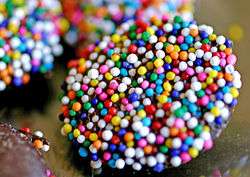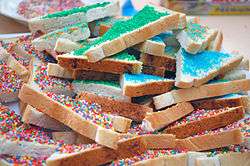Nonpareils
 Multicolor nonpareil balls coating the top of a chocolate nonpareil | |
| Alternative names |
Sprinkle Chips (US) Hundreds & Thousands / 100s & 1000s (UK) |
|---|---|
| Type | Confectionery |
| Main ingredients | Sugar, starch, food coloring |
| Look up nonpareil in Wiktionary, the free dictionary. |
Nonpareils (or hundreds and thousands outside North America) are a decorative confectionery of tiny balls made with sugar and starch, traditionally an opaque white but now available in many colors. Their origin is uncertain, but they may have evolved out of the pharmaceutical use of sugar, as they were a miniature version of comfits.[1] The French name has been interpreted to mean they were "without equal" for intricate decoration of cakes, desserts, and other sweets, and the elaborate pièces montées constructed as table ornaments.[2]
The term nonpareil can also refer to a specific confection made using nonpareils, namely, flat discs of chocolate coated with nonpareils, which are also known as chocolate nonpareils.
History
An 18th-century American recipe for a frosted wedding cake calls for nonpareils as decoration. By the early 19th century, colored nonpareils seem to have been available in the U.S. The popular cookbook author Eliza Leslie suggests the use of red and green nonpareils for decorating a Queen cake, but strongly suggests white nonpareils are most suitable for pink icing on a pound cake in her 1828 Seventy-five Recepts for Pastries, Cakes and Sweetmeats.[3]

In 1844, Eleanor Parkinson, of a well-known Philadelphia family of professional confectioners, first published her book The Complete Confectioner,[4] in which she described how to make nonpareils following her comfit-making procedure, which involved multiple hot pots and hot syrup.
Görlitz, Germany was the birthplace of the German version of nonpareils, popularly known in Germany as liebesperlen (German: love pearls). Invented by confectioner Rudolf Hoinkis (1876–1944), the name derives from a conversation Hoinkis had with his wife, proclaiming he loved her like these "pearls," the nonpareil. Unsure of what to call the treat he invented, his wife suggested calling them love pearls, and the name stuck. The factory where he first manufactured the treat, founded in 1896, is now run by his great-grandson, Mathias.[5]
In the United States, traditional nonpareils gave way for most purposes by the mid 20th century to "sprinkles" (known in some parts as "jimmies"), confections nearly as small but usually oblong rather than round and soft rather than brittle. Like nonpareils, their function is more decorative than gustatory as their actual taste is indistinct, and the products they are applied to are usually themselves very high in sugar. Candy-covered anise seeds called muisjes, sometimes mistaken for traditional nonpareils, are sometimes offered at breakfast in the Netherlands to be served on bread and butter. They are, however, usually served on rusk to celebrate the birth of a child. This is known as "beschuit met muisjes."
In the UK, Australia and New Zealand, nonpareils are known as "hundreds-and-thousands." In Australia and New Zealand, they are often eaten on top of patty cakes or on buttered bread as fairy bread, as festive items at children's birthday parties.
Chocolate nonpareils
The term "nonpareils" can also refer to a specific confection: a round flat chocolate drop with the upper surface coated with nonpareils.[6] This confection is also referred to as "chocolate nonpareils." Nestlé makes a variety marketed as Sno-Caps. In Australia, these confections are commonly known as "chocolate freckles," or simply "freckles." Nonpareils are also sold in the United Kingdom as "Jazzles," "Jazzies," "jazz drops" and "Snowies" (the latter being of the white chocolate variety).
See also
References
- ↑ Richardson, Tim (2002). Sweets: A History of Candy. Bloomsbury. ISBN 1-58234-307-1.
- ↑ Larousse Gastronomique. Clarkson Potter. 2001. ISBN 0-609-60971-8.
- ↑ Leslie, Eliza. "Seventy-five Recepts for Pastry, Cakes, and Sweetmeats". Feeding America: The Historic American Cookbook Project. Retrieved 2009-11-19. External link in
|publisher=(help) - ↑ Parkinson, Eleanor. "The Complete Confectioner". Feeding America: The Historic American Cookbook Project. Retrieved 2009-11-19. External link in
|publisher=(help) - ↑ "Nonpareil - sweet treat from Görlitz". dw.com. Deutsche Welle. 28 April 2016. Retrieved 1 May 2017.
- ↑ "Definition of Nonpareil by Merriam-Webster". www.merriam-webster.com. Retrieved 30 November 2016.